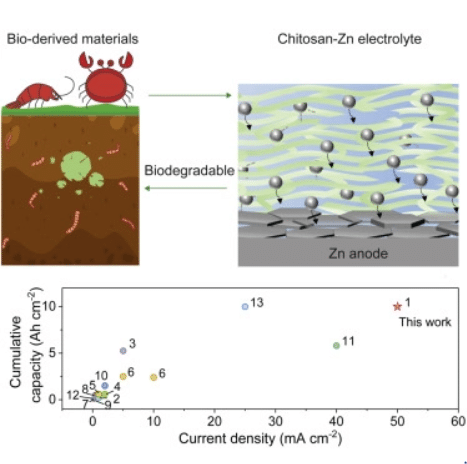Researchers developed a sustainable battery using biodegradable electrolytes produced from crab shells

‘, DOI:https://doi.org/10.1016/j.matt.2022.07.015)
Batteries utilize electrolyte ions to commute between positively and negatively charged terminals. An electrolytic can be in different forms such as liquid, paste, or gel and many batteries use flammable and corrosive chemicals. The new battery invented which is capable to store power from large-scale wind and solar sources uses a gel electrolyte produced from a biological material called chitosan.
“Chitosan is a derivative product of chitin. Chitin has a lot of sources, including the cell walls of fungi, the exoskeletons of crustaceans, and squid pens,” says Hu. “The most abundant source of chitosan is the exoskeletons of crustaceans, including crabs, shrimps, and lobsters, which can be easily obtained from seafood waste. You can find it on your table.”
There is a huge demand for renewable energy and electric vehicles desire batteries that store generated energy and power engines. Hence, Scientists invented a zinc battery with a biodegradable electrolyte from an unexpected source i.e. crab shells. “Vast quantities of batteries are being produced and consumed, raising the possibility of environmental problems,” says lead author Liangbing Hu, director of the University of Maryland’s Center for Materials Innovation. “For example, polypropylene and polycarbonate separators, which are widely used in Lithium-ion batteries, take hundreds or thousands of years to degrade and add to the environmental burden.”
The production of the metal component from crab shells takes an enormous amount of time. A biodegradable electrolyte means that about two-thirds of the battery could be broken down by microbes—this chitosan electrolyte broke down completely within five months. This results in recyclable metal Zinc production.“Zinc is more abundant in earth’s crust than lithium,” says Hu. “Generally speaking, well-developed zinc batteries are cheaper and safer.” This zinc and chitosan battery provides energy efficiency of 99.7% after 1000 battery cycles. The researchers continue their work to invent batteries that are more environmentally friendly.
Click here for the Published Research Paper






